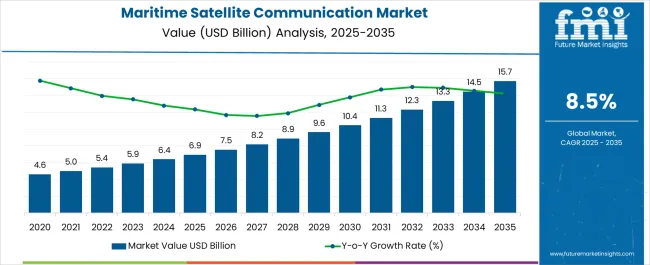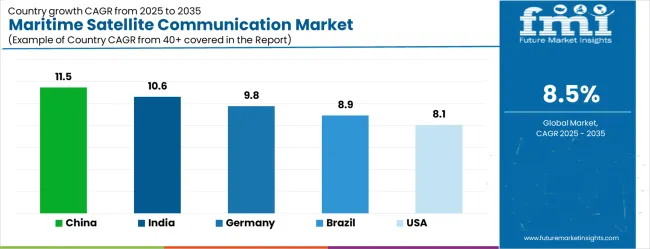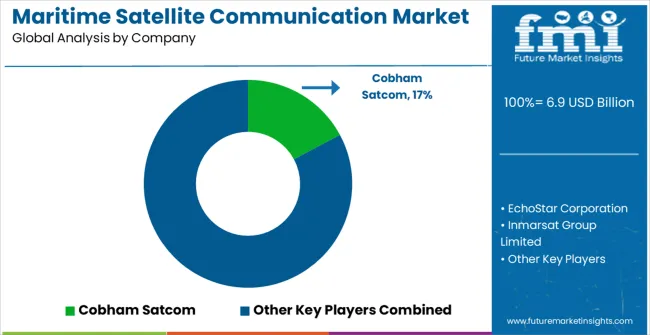The Maritime Satellite Communication Market is estimated to be valued at USD 6.9 billion in 2025 and is projected to reach USD 15.7 billion by 2035, registering a compound annual growth rate (CAGR) of 8.5% over the forecast period.

| Metric | Value |
|---|---|
| Maritime Satellite Communication Market Estimated Value in (2025 E) | USD 6.9 billion |
| Maritime Satellite Communication Market Forecast Value in (2035 F) | USD 15.7 billion |
| Forecast CAGR (2025 to 2035) | 8.5% |
The Maritime Satellite Communication market is experiencing strong growth, driven by increasing demand for reliable connectivity and data transfer capabilities across the global maritime sector. Adoption is being fueled by the rising need for real-time navigation, vessel monitoring, operational coordination, and crew welfare services. Advanced satellite technologies, including Very Small Aperture Terminal (VSAT) systems, are enabling high-speed, uninterrupted communication even in remote oceanic regions, enhancing safety, operational efficiency, and regulatory compliance.
Growth is also supported by the increasing use of data-intensive applications, such as automated tracking, predictive maintenance, and cloud-based fleet management. The expanding global merchant shipping industry, along with heightened regulatory focus on safety, environmental monitoring, and maritime security, is further contributing to adoption.
Investments in broadband infrastructure and next-generation satellite systems are accelerating deployment As vessels increasingly rely on digital communication and integrated network solutions, the market is expected to witness sustained growth, with service providers focusing on improving coverage, reliability, and cost efficiency to meet evolving maritime communication requirements.
The maritime satellite communication market is segmented by type, service, end user, and geographic regions. By type, maritime satellite communication market is divided into Very Small Aperture Terminal (VSAT) and Mobile Satellite Services (MSS). In terms of service, maritime satellite communication market is classified into Data, Video, Voice, and Tracking And Monitoring. Based on end user, maritime satellite communication market is segmented into Merchant Shipping, Fishing, Passenger Ships, Leisure Vessels, and Offshore. Regionally, the maritime satellite communication industry is classified into North America, Latin America, Western Europe, Eastern Europe, Balkan & Baltic Countries, Russia & Belarus, Central Asia, East Asia, South Asia & Pacific, and the Middle East & Africa.

The Very Small Aperture Terminal (VSAT) type segment is projected to hold 54.2% of the Maritime Satellite Communication market revenue in 2025, establishing it as the leading type. Growth is being driven by its ability to provide high-speed, stable, and secure connectivity to vessels across deep-sea and coastal routes. VSAT systems enable seamless voice, data, and multimedia transmission, supporting operational efficiency, crew welfare, and regulatory compliance.
Scalability, low latency, and ease of installation contribute to its preference among maritime operators. The system’s compatibility with advanced data management, navigation, and monitoring applications further reinforces adoption. Increasing reliance on real-time weather updates, automated reporting, and operational intelligence is enhancing demand for VSAT technology.
With advancements in satellite networks, including Ka-band and L-band connectivity, VSAT systems are capable of delivering uninterrupted service in remote maritime environments As global maritime traffic continues to expand and digitalization accelerates, VSAT is expected to maintain its dominant position, supported by high reliability, coverage, and adaptability to evolving communication needs.

The data service segment is anticipated to account for 36.7% of the market revenue in 2025, making it the leading service category. Growth in this segment is driven by the increasing need for continuous transmission of navigation data, operational metrics, fleet management information, and weather updates to support efficient maritime operations. Data services enable real-time monitoring, predictive maintenance, and compliance reporting, enhancing operational safety and reducing downtime.
Integration with cloud-based platforms and analytics tools allows for improved decision-making and optimization of vessel performance. Maritime operators are increasingly leveraging data services for cargo tracking, route optimization, and regulatory compliance. As vessels become more reliant on digital operations, the demand for high-speed, secure, and scalable data communication services continues to grow.
Technological advancements in satellite communication networks, including improved bandwidth and low-latency performance, further reinforce adoption The segment is expected to sustain its leading position, supported by the growing volume of data-intensive applications and the critical role of information flow in modern maritime operations.

The merchant shipping end-user segment is projected to hold 31.5% of the market revenue in 2025, establishing it as the leading end-use category. Growth is being driven by the expanding global fleet, increasing trade volumes, and the need for reliable satellite communication to ensure operational efficiency, safety, and compliance with maritime regulations. Vessels in this segment rely heavily on real-time data for navigation, cargo tracking, route optimization, and predictive maintenance.
Communication solutions, including VSAT systems and advanced data services, enable seamless connectivity for vessel-to-shore operations and crew welfare applications. The adoption of digitalized fleet management platforms and automated reporting systems is further reinforcing the importance of satellite communication in this segment.
Increased regulatory focus on safety, environmental monitoring, and emissions reporting is also accelerating deployment As merchant shipping operators continue to prioritize operational reliability, cost efficiency, and digitalization, the segment is expected to maintain its market leadership, supported by technological advancements and growing dependence on integrated communication networks.
Maritime satellite communication system market is growing significantly due to increase in need of reliable data communication across remote marine regions. The scope of maritime satellite communication has increased due to rise in operational efficiency and on board security. It is used in various applications like naval forces, merchant navy and coastal fields.
The three main components of very small aperture technology are satellite, central hub and number of smaller nodes. These components are placed at various remote location connected together in either star or mesh topology using satellite network. Moreover, if there is need to implement additional network in the current network, it is done by network operation center (NOC) at central hub.

| Country | CAGR |
|---|---|
| China | 11.5% |
| India | 10.6% |
| Germany | 9.8% |
| Brazil | 8.9% |
| USA | 8.1% |
| UK | 7.2% |
| Japan | 6.4% |
The Maritime Satellite Communication Market is expected to register a CAGR of 8.5% during the forecast period, exhibiting varied country level momentum. China leads with the highest CAGR of 11.5%, followed by India at 10.6%. Developed markets such as Germany, France, and the UK continue to expand steadily, while the USA is likely to grow at consistent rates. Japan posts the lowest CAGR at 6.4%, yet still underscores a broadly positive trajectory for the global Maritime Satellite Communication Market. In 2024, Germany held a dominant revenue in the Western Europe market and is expected to grow with a CAGR of 9.8%. The USA Maritime Satellite Communication Market is estimated to be valued at USD 2.5 billion in 2025 and is anticipated to reach a valuation of USD 2.5 billion by 2035. Sales are projected to rise at a CAGR of 0.0% over the forecast period between 2025 and 2035. While Japan and South Korea markets are estimated to be valued at USD 376.7 million and USD 199.4 million respectively in 2025.

| Item | Value |
|---|---|
| Quantitative Units | USD 6.9 Billion |
| Type | Very Small Aperture Terminal (VSAT) and Mobile Satellite Services (MSS) |
| Service | Data, Video, Voice, and Tracking And Monitoring |
| End User | Merchant Shipping, Fishing, Passenger Ships, Leisure Vessels, and Offshore |
| Regions Covered | North America, Europe, Asia-Pacific, Latin America, Middle East & Africa |
| Country Covered | United States, Canada, Germany, France, United Kingdom, China, Japan, India, Brazil, South Africa |
| Key Companies Profiled | Cobham Satcom, EchoStar Corporation, Inmarsat Group Limited, Iridium Communications Inc., KVH Industries Inc., Marlink SAS, NSSL Global Limited, SES Satellite, Thuraya Telecommunications Company, and Viasat Inc. |
The global maritime satellite communication market is estimated to be valued at USD 6.9 billion in 2025.
The market size for the maritime satellite communication market is projected to reach USD 15.7 billion by 2035.
The maritime satellite communication market is expected to grow at a 8.5% CAGR between 2025 and 2035.
The key product types in maritime satellite communication market are very small aperture terminal (vsat) and mobile satellite services (mss).
In terms of service, data segment to command 36.7% share in the maritime satellite communication market in 2025.






Our Research Products

The "Full Research Suite" delivers actionable market intel, deep dives on markets or technologies, so clients act faster, cut risk, and unlock growth.

The Leaderboard benchmarks and ranks top vendors, classifying them as Established Leaders, Leading Challengers, or Disruptors & Challengers.

Locates where complements amplify value and substitutes erode it, forecasting net impact by horizon

We deliver granular, decision-grade intel: market sizing, 5-year forecasts, pricing, adoption, usage, revenue, and operational KPIs—plus competitor tracking, regulation, and value chains—across 60 countries broadly.

Spot the shifts before they hit your P&L. We track inflection points, adoption curves, pricing moves, and ecosystem plays to show where demand is heading, why it is changing, and what to do next across high-growth markets and disruptive tech

Real-time reads of user behavior. We track shifting priorities, perceptions of today’s and next-gen services, and provider experience, then pace how fast tech moves from trial to adoption, blending buyer, consumer, and channel inputs with social signals (#WhySwitch, #UX).

Partner with our analyst team to build a custom report designed around your business priorities. From analysing market trends to assessing competitors or crafting bespoke datasets, we tailor insights to your needs.
Supplier Intelligence
Discovery & Profiling
Capacity & Footprint
Performance & Risk
Compliance & Governance
Commercial Readiness
Who Supplies Whom
Scorecards & Shortlists
Playbooks & Docs
Category Intelligence
Definition & Scope
Demand & Use Cases
Cost Drivers
Market Structure
Supply Chain Map
Trade & Policy
Operating Norms
Deliverables
Buyer Intelligence
Account Basics
Spend & Scope
Procurement Model
Vendor Requirements
Terms & Policies
Entry Strategy
Pain Points & Triggers
Outputs
Pricing Analysis
Benchmarks
Trends
Should-Cost
Indexation
Landed Cost
Commercial Terms
Deliverables
Brand Analysis
Positioning & Value Prop
Share & Presence
Customer Evidence
Go-to-Market
Digital & Reputation
Compliance & Trust
KPIs & Gaps
Outputs
Full Research Suite comprises of:
Market outlook & trends analysis
Interviews & case studies
Strategic recommendations
Vendor profiles & capabilities analysis
5-year forecasts
8 regions and 60+ country-level data splits
Market segment data splits
12 months of continuous data updates
DELIVERED AS:
PDF EXCEL ONLINE
Maritime Cybersecurity Market Size and Share Forecast Outlook 2025 to 2035
Maritime Patrol Aircraft Market Size and Share Forecast Outlook 2025 to 2035
Maritime Patrol Naval Vessels Market Growth - Trends & Forecast 2025 to 2035
Satellite Launch Vehicle Market Forecast Outlook 2025 to 2035
Satellite Simulator Market Size and Share Forecast Outlook 2025 to 2035
Satellite Vessel Tracking Market Size and Share Forecast Outlook 2025 to 2035
Satellite IoT Market Size and Share Forecast Outlook 2025 to 2035
Satellite Phased Array Antenna Market Size and Share Forecast Outlook 2025 to 2035
Satellite Solar Cell Materials Market Size and Share Forecast Outlook 2025 to 2035
Satellite-based 5G Network Market Size and Share Forecast Outlook 2025 to 2035
Satellite Launch Vehicle (SLV) Market Size and Share Forecast Outlook 2025 to 2035
Satellite Manufacturing Market Size and Share Forecast Outlook 2025 to 2035
Satellite Cables And Assemblies Market Size and Share Forecast Outlook 2025 to 2035
Satellite Component Market Size and Share Forecast Outlook 2025 to 2035
Satellite As A Service Market Size and Share Forecast Outlook 2025 to 2035
Satellite Payloads Market Size and Share Forecast Outlook 2025 to 2035
Satellite Modem Market Size and Share Forecast Outlook 2025 to 2035
Satellite Ground Station Market Trends – Growth & Forecast 2024-2034
Satellite Antenna Market
Satellite Communication Components Market Size and Share Forecast Outlook 2025 to 2035

Thank you!
You will receive an email from our Business Development Manager. Please be sure to check your SPAM/JUNK folder too.
Chat With
MaRIA